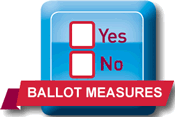2012 Ballot Measures: A Preview
Daily News Article — Posted on October 30, 2012
NOTE: Anything that appears on a ballot other than a candidate running for office is called a ballot measure. Ballot measures are broken down into two distinct categories – initiatives (or propositions) and referendums. (see “Background” below the questions for more info)
 (by Jennie Drage Bowser, NCSL.org) – Voters in 38 states will consider 174 statewide measures on November 6th. That breaks down into 42 initiatives and 12 popular referendums, 115 measures referred to the ballot by state legislatures, and five measures that fall into unique categories. Learn more about all 172 measures in NCSL’s Ballot Measures Database (NCSL – National Conference of State Legislatures – see link under “Resources” below).
(by Jennie Drage Bowser, NCSL.org) – Voters in 38 states will consider 174 statewide measures on November 6th. That breaks down into 42 initiatives and 12 popular referendums, 115 measures referred to the ballot by state legislatures, and five measures that fall into unique categories. Learn more about all 172 measures in NCSL’s Ballot Measures Database (NCSL – National Conference of State Legislatures – see link under “Resources” below).
Trends in 2012
A number of trends are notable in this year’s crop of ballot measures, both in terms of the numbers and the issues represented.
There are far more popular referenda on the ballot this year than usual.
The number of citizen initiatives on the ballot remains low compared to the numbers we’ve seen over the past decade.
Key issues on this year’s ballot include:
- Education, particularly the funding of education through tax increases.
- Drug policy, most notably the legalization of recreational marijuana in three states.
- Marriage: [traditional marriage between one man and one woman, vs. same sex marriage]
- Health care, with states continuing to debate the implementation of the Affordable Care Act [also known as Obamacare].
- The right to hunt and fish, and farming and ranching practices.
- Bond measures, with proposals totaling $2.7 billion on the ballot in nine states. [A bond measure is placed on the ballot by the legislature asking citizens to approve or deny additional proposed spending by the government for a certain purpose, many times education spending.]
- Legislatures, with questions regarding term limits, sessions, legislator compensation and rules for certain votes in the legislature on the ballot in 2012.
- Abortion, casinos, criminal justice and elections round out this year’s set of trending issues on statewide ballots.
- From the liberal side, teacher unions are pushing back against changes enacted by the legislature in Idaho and South Dakota
- Conservatives in Maryland and Washington are seeking to overturn changes that legalize same-sex marriage
Questions
NOTE TO STUDENTS: Read the "Background" below before answering the questions.
1. Define ballot measure.
2. a) List the two types of citizen ballot measures.
b) What is the difference between the two?
3. What is a legislative measure?
4. In how many states can citizens petition to add initiatives and/or referendums to the ballot?
5. List the total number and breakdown of ballot measures (including legislative measures) which will be voted on across the country in the 2012 election.
6. List at least 5 of the key ballot measure topics for this election (using a word or phrase to describe each topic).
7. How are this year's ballot measures different from many past elections?
8. a) Does your state practice direct democracy through the ballot measure process? (if not, choose a neighboring state to answer the following)
b) What initiatives or referendums are on your state’s ballot in the upcoming election?
c) How would you cast your vote on any of the measures? (Choose one.) Explain your answer.
Background
BALLOT MEASURES:
Anything that appears on a ballot other than a candidate running for office is called a ballot measure. Ballot measures are broken down into two distinct categories – initiatives (or propositions) and referendums.
- Initiative – Citizens, collecting signatures on a petition, place advisory questions, memorials, statutes (laws) or constitutional amendments on the ballot for the citizens to adopt or reject. “Initiative” refers to newly drafted legislation submitted directly to a popular vote as an alternative to adoption by a state legislature. Twenty-four states have the initiative process.
- Referendum – In many of the same states the citizens have the referendum process – the ability to reject laws or amendments proposed or already passed by the state legislature.
The terms above are all forms of “direct democracy” practiced by various states. In a direct democracy, all citizens, without the intermediary of elected or appointed officials, can participate in making public decisions. Ballot measures are a form of direct democracy practiced by many states in the U.S.
Find a list of 2012 ballot measures at ballotpedia.org. (Scroll down to November for a list of ballot measures by state. Click on the name of the ballot measures in your state for a full explanation and background on the measure.) This website actually explains more about each ballot measure than the NCSL website - but for a list through NCSL, go to: ncsl.org/legislatures-elections/elections/ballot-measures-database.aspx.
NOTE: In addition to the citizen initiated ballot measures explained above, the state legislature can place a proposal placed on the ballot. It is called a legislative measure or legislative proposition (or sometimes "referred" measure). All states permit legislative measures and all states except for Delaware require constitutional amendments to be approved by the voters at large. In some states, legislatures place non-binding advisory measures on the ballot. Legislative measures are much more common than initiatives and referendums, and are about twice as likely to be approved. Some states, such as Florida, also allow certain commissions to refer measures to the ballot.
